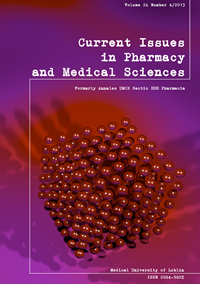A comparison of vitamin C content determination by chromatographic and spectrophotometric methods according to standard PN-A-04019:1998
DOI:
https://doi.org/10.12923/j.2084-980X/26.4/a.21Keywords:
vitamin C, ascorbic acid, dehydroascorbic acid, methods of determinationAbstract
Vitamin C performs many important functions in the human organism. Besides, it is used in the therapy and prevention of many diseases, which is why the methods applied to determine it should ensure the correct results. The present paper compares the results of vitamin C determination by means of the spectrophotometric method in agreement with the binding standard PN-A-04019:1998 and the proposed method of the reversed-phase high-performance liquid chromatography with spectrophotometric detection. The comparison was made using the method of calculating the proportion of mean results and the uncertainty of its determination. The analysis of a sample of the certified reference material BCR-43 was conducted. It was shown that because the content of dehydroascorbic acid was not considered, the result obtained by the standardized spectrophotometric method differs in a s ta tis ti cally significant way from the certified value, as opposed to the result obtained by the chromatographic method. Results of determining vitamin C content in blackcurrant, apple and grapefruit juices by means of the two methods indicate statistically significant differences. Compatible results were obtained only for orange juice. This is caused by insufficient selectivity of the spectrophotometric method of vitamin C determination. The suggested chromatographic method is more selective than the spectrophotometric method and it enables to consider the content of dehydroascorbic acid. That is why it should be recommended for routine determinations of vitamin C content.
References
1. AOAC. (1990). Official methods of analysis of the Association of Official Analytical Chemists, 15th ed. Arlington VA: Association of Official Analytical Chemists; p. 1058.
2. Arya S.P., Meenakshi M., Preeti J.: Photometric Methods for the Determination of Vitamin C. Anal. Sci., 14, p. 889, 1998.
3. Arya S.P., Mahajan M., Jain P.:. Non-spectrophotometric methods for the determination of Vitamin C. Anal. Chim. Acta, 417, 1, 2000.
4. CEN/TC 275 Food analysis – Horizontal methods, BT N 8434, (Draft Resolution BT C65/2010), 2010.
5. Danielczuk J., Pietrzykowski R., Zieliński W.: Comparative study of the enzymatic method for determination of vitamin C with routine methods according to ISO. Pol. J. Food Nutr. Sci., 13/54, 1, 41, 2004.
6. Davey M.W. et al.: Plant L-ascorbic acid: chemistry, function, metabolism, bioavailability and effects of processing. J Sci Food Agric, 80, 825, 2000.
7. Fenoll J. et. al.: Simultaneous determination of ascorbic and dehydroascorbic acids in vegetables and fruits by liquid chromatography with tandem-mass spectrometry. Food Chem., 127, 340, 2011.
8. Hernández Y., Gloria Lobo M., González M.: Determination of vitamin C in tropical fruits: A comparative evaluation of methods, Food Chem., 96, 4, 2006.
9. Konieczka P., Namiesnik J. (2009). Quality Assurance and Quality Control in the Analytical Chemical Laboratory. A Practical Approach. CRC Press, p. 180
10. Li Y, Schellhorn HE.: New developments and novel therapeutic perspectives for vitamin C. J Nutr., 137, 10, 2171, 2007.
11. Linsinger T.: Application Note 1: Comparison of a measurement result with the certified value, European Commission - Joint Research Centre IRMM., 2010.
12. Lykkesfeldt J.: Determination of Ascorbic Acid and Dehydroascorbic Acid in Biological Samples by High-Performance Liquid Chromatography Using Subtraction Methods: Reliable Reduction with Tris[2-carboxyethyl]phosphine Hydrochloride. Anal. Biochem., 282, 89, 2000.
13. Mazurek A., Pankiewicz U.: Changes of dehydroascorbic acid content in relation to total content of vitamin C in selected fruits and vegetables. Acta Sci. Pol., Hortorum Cultus, 11, 6, 169, 2012.
14. Novakova L., Solich P., Solichova D.: HPLC methods for simultaneous determination of ascorbic and dehydroascorbic acids. Trends Anal. Chem., 27, 10, 942, 2008.
15. Novakova L., Solichova D., Solich P.: Hydrophilic interaction liquid chromatography-charged aerosol detection as a straightforward solution for simultaneous analysis of ascorbic acid and dehydroascorbic acid. J. Chromatogr A., 1216, 21, 4574, 2009.
16. Sato Y., et al.: Determination of dehydroascorbic acid in mouse tissues and plasma by using tris(2-carboxyethyl)phosphine hydrochloride as reductant in metaphosphoric acid/ethylenediaminetetraacetic acid solution. Biol. Pharm. Bull., 33, 364, 2010.
17. Schlueter A.K., Johnston C.S.: Vitamin C: Overview and Update. JEBCAM, 16, 49, 2011.
18. Wills R.B.H., Wimalasiri P., Heather G.: Dehydroascorbic acid levels in fresh fruit and vegetables in relation to total vitamin C activity. J. Agric. Food Chem., 32, 836, 1984.
Downloads
Published
Issue
Section
License
Copyright (c) 2013 Autorzy

This work is licensed under a Creative Commons Attribution-NonCommercial-NoDerivatives 3.0 Unported License.


